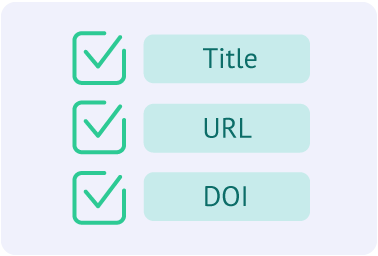Free APA Citation Generator by AHelp
Meet the benefits of APA Citation Generator by AHelp

Accurate in-text citations
Make sure your in-text citations are formatted correctly according to APA guidelines, regardless of the source you cite. This includes the author's last name, the year of publication, and, if necessary, page numbers.
Proper reference page
Create a comprehensive reference page at the end of your document. Each entry is formatted as per APA standards, including elements like the author's name, publication year, title of the work, and source information.
Handling Multiple Sources
Manage a variety of source types - books, journal articles, websites, and more. Format each source type according to APA rules, accommodating the specific details required for each.Perfect APA Style Citation Machine

APA citation generator
The American Psychological Association (APA) citation style is a widely used format for writing academic papers, particularly in humanities, such as psychology, education, social sciences, and other related disciplines. The APA style is designed to promote clarity and consistency in scholarly writing, with a strong emphasis on crediting sources to avoid plagiarism.
How to create APA citations
When referencing in APA 7 Style, attention to detail is critical as there’s always a risk of minor errors. Nonetheless, the AHelp Citation Generator eliminates these concerns. This user-friendly tool ensures quick and precise ARA formatting aligned with the latest updates in the 7th edition of the APA Publication Manual (2020). Just input your source information, and our citation machine will swiftly create the necessary references or in-text citations for you.
How to use AHelp Citation Generator for In-Text Citations
APA uses an author-date citation system. In-text citations include the author’s last name, the year of publication, and a page number for direct quotes or specific parts of a source. Look at how an in-text citation differs from a full citation (or a bibliography entry):
In-text citation

Full citation

How to create references in APA Citation Style?
A reference list at the end of the document provides full details of all sources cited in the text. AHelp citation maker will arrange this list alphabetically by the author’s last name and with a hanging indent as required by APA Style.

Note: The first book has a DOI (digital object identifier). It is a unique string of letters and numbers that refers to a specific article, ebook, or other online work. DOIs usually can be found on the first page of a work or on the information page about the work.
Follow these rules for including DOIs and URLs in references:
- If a work has a DOI, include it in the reference, even if you used the print version. Do not include a URL.
- If an online work has no DOI:
- If the work is on a website, include a URL directly to the work. You may use a URL-shortening service for long links.
- If the work is within a library database, do not provide a URL.
10 Key Things To Remember When Citing in APA Style
Citing sources in APA (American Psychological Association) format is crucial for academic writing, particularly in the social sciences. Besides basic formatting rules and in-text citation requirements, there are some key points to remember when citing in APA format:
Multiple Authors: For works by two authors, cite both names every time the reference occurs. For three to five authors, cite all authors the first time, and then use the first author’s last name followed by et al. For six or more authors, use the first author’s last name followed by et al from the first citation.
No Author: If no author is available, start the citation with the work’s title.
Dates: Always include the year of publication. If it’s a periodical, include the year and exact publication date (year, month day).
Titles: Capitalize only the first word of the title and subtitle and any proper nouns.
Journal Articles: For journal articles, include the title of the article, the name of the journal, the volume and issue number, and page numbers.
DOI and URLs: Include a Digital Object Identifier (DOI) if available for online sources. If not, include a direct URL to the source.
Page Numbers: Include page numbers when quoting or referring to a specific part of a source.
Reference List: All in-text citations should have a corresponding full reference at the end of your work in the reference list.
Editions: If you use a book that is not the first edition, include the edition number in your citation.
Secondary Sources: When citing a source you found in another source, mention the source in the text and list the secondary source in your reference list.


